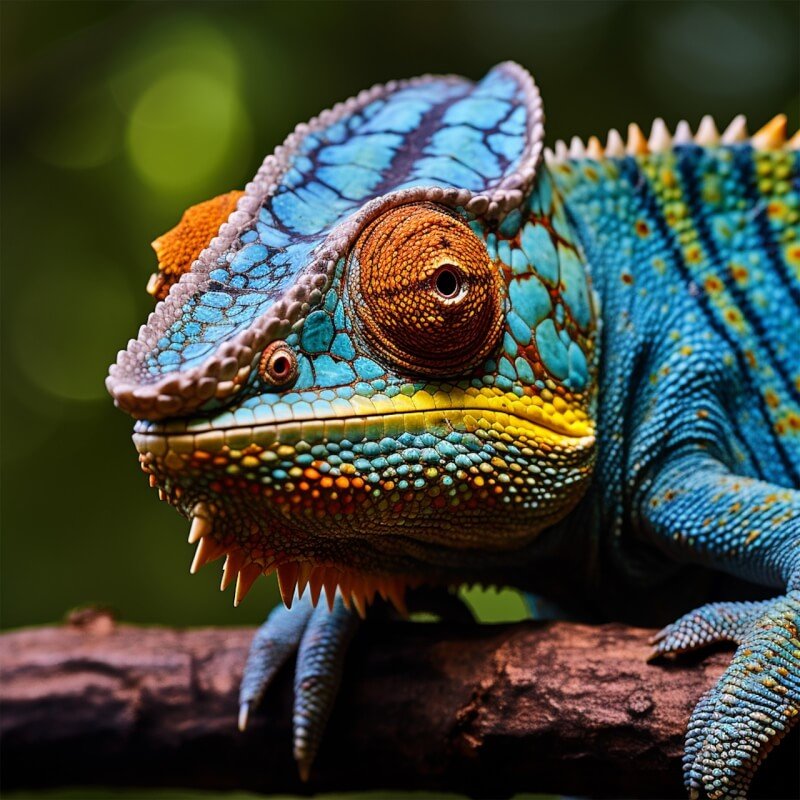If you’re the proud owner of a pet chameleon, you may find yourself wondering whether it’s safe to handle them regularly. After all, chameleons are known for their delicate nature and unique ability to blend into their surroundings. In this article, we’ll explore the safety aspects of handling your pet chameleon and provide some insights to ensure a positive and enriching experience for both you and your scaly friend.

Safety Concerns of Handling Chameleons
When it comes to handling chameleons, there are several safety concerns that pet owners need to be aware of. These concerns include the risk of stress and anxiety, the potential for injury, the transmission of diseases, and skin damage and shedding issues.
Risk of Stress and Anxiety
Chameleons are known to be sensitive creatures, and handling them can often cause stress and anxiety. They may feel threatened or overwhelmed by the presence of humans and may react defensively, leading to potential harm for both the chameleon and the handler. It’s important to consider the individual temperament and comfort level of your chameleon before attempting to handle them.
Potential for Injury
Handling chameleons can also pose a risk of injury. Chameleons have delicate bodies and limbs, and any rough handling or improper gripping can cause harm. Their tails, in particular, are prone to being injured if mishandled. It is crucial to handle them with care and gentleness to prevent any accidents or injuries.
Transmission of Diseases
Another safety concern when handling chameleons is the potential transmission of diseases. Chameleons can carry various parasites and bacteria that can be harmful to humans. By handling your chameleon frequently, you increase the risk of exposure to these pathogens. It is crucial to practice good hygiene, such as washing your hands thoroughly after handling your chameleon, to minimize the risk of disease transmission.
Skin Damage and Shedding Issues
Chameleons regularly shed their skin, and handling them during this process can cause skin damage and discomfort. Shedding can be a delicate and sensitive time for chameleons, and any rough handling can interrupt the shedding process or cause injuries to the new skin. It’s important to be mindful of their shedding cycles and avoid handling them during this time whenever possible.
Factors to Consider Before Handling Chameleons
Before attempting to handle your chameleon, there are several factors you should take into consideration. These factors include the age and health of the chameleon, the level of taming and socialization, environmental conditions, and the chameleon’s body language and behavior.
Age and Health of the Chameleon
The age and health of your chameleon play a significant role in determining whether handling is appropriate. Younger or weaker chameleons may be more susceptible to stress and injury, so it’s essential to consider their overall health and well-being before attempting to handle them. It’s always best to consult with a veterinarian to ensure your chameleon is in optimal condition for handling.
Level of Taming and Socialization
Chameleons vary in their level of taming and socialization. Some individuals may be more comfortable with human interaction, while others may be more skittish or defensive. It’s important to gauge your chameleon’s comfort level and slowly introduce handling if they seem receptive. Building trust and familiarity over time can help reduce stress and make handling a more positive experience for both you and your chameleon.
Environmental Conditions
Environmental conditions also play a crucial role in determining whether handling is appropriate. Chameleons are highly sensitive to changes in temperature, humidity, and lighting. If your chameleon is experiencing any environmental stressors, such as improper temperature regulation or inadequate lighting, it’s best to address those issues first before attempting to handle them. A stable and comfortable environment will contribute to the overall well-being of your chameleon and make handling safer.
Chameleon’s Body Language and Behavior
Observing your chameleon’s body language and behavior can give you valuable insights into whether handling is appropriate at a given time. If your chameleon exhibits signs of stress or discomfort, such as color changes, aggressive postures, or excessive hiding, it’s important to respect their boundaries and avoid handling until they feel more at ease. It’s crucial to understand and respond to your chameleon’s cues to ensure their safety and well-being.
Proper Techniques for Handling Chameleons
When it comes to handling chameleons, following proper techniques is essential to ensure the safety and well-being of both you and your pet. Here are some key techniques to keep in mind:
Gaining Trust and Establishing Familiarity
Before attempting to handle your chameleon, it’s crucial to establish trust and familiarity. Spend time near their enclosure, talking to them in a calm and soothing voice, and offering them treats. This will help them associate your presence with positive experiences and build a bond of trust. Patience and consistency are key when working towards gaining your chameleon’s trust.
Correct Hand Placement and Posture
When it comes to actually handling your chameleon, it’s important to use the correct hand placement and posture. Support the chameleon’s body and limbs gently but firmly, ensuring that you avoid gripping too tightly or placing pressure on sensitive areas. The best approach is to let your chameleon walk onto your open hand rather than forcefully picking them up. By allowing them to move onto your hand voluntarily, they will feel more in control and comfortable.
Avoiding Sudden Movements
Chameleons are highly sensitive to sudden movements, which can alarm and stress them. It’s important to move slowly and deliberately when handling them to avoid startling them. Sudden movements can trigger a defensive response, potentially leading to bites or injuries. By maintaining a calm and gentle approach, you can help minimize stress and create a safer handling experience.
Limiting Handling Time
Chameleons are not particularly fond of prolonged handling sessions. It’s important to keep handling sessions short and infrequent to avoid overwhelming or traumatizing your chameleon. Start with just a few minutes of handling and gradually increase the duration as your chameleon becomes more comfortable. Always pay attention to their body language and behavior, and if they show signs of stress or discomfort, it’s best to end the handling session and give them time to relax in their enclosure.
Alternative Forms of Interaction
Handling chameleons isn’t the only way to interact with them. There are alternative forms of interaction that can help you bond with your chameleon while minimizing stress and potential risks.
Observing from a Distance
Chameleons are fascinating creatures to observe, and simply spending time near their enclosure and watching their natural behaviors can be a rewarding experience. Observing from a distance allows your chameleon to feel secure in their environment while still providing you with the opportunity to learn more about their unique characteristics and habits.
Creating a Bond through Feeding
Feeding time can serve as a way to create a bond with your chameleon. By hand-feeding them their favorite treats or insects, you can establish positive associations and build trust. This form of interaction allows your chameleon to approach you on their terms and reinforces the idea that you are a provider of good things.
Environmental Enrichment Activities
Providing environmental enrichment activities in your chameleon’s enclosure can also enhance their overall well-being and serve as a form of interaction. Adding branches or plants for climbing, introducing new textures or objects for exploration, and providing puzzles or foraging opportunities can engage their natural instincts while reducing the need for excessive handling.

Preparing the Environment for Safe Handling
Creating a safe environment is crucial for handling chameleons. By taking the necessary precautions and preparing their enclosure, you can minimize the potential risks and ensure a safer handling experience.
Secure Enclosures and Escape Prevention
Chameleons are known for their climbing abilities and can be surprisingly quick when it comes to escaping. It’s important to ensure that their enclosure is secure and escape-proof. Double-check all openings, such as doors or vents, and make sure they are tightly secured. Regularly inspect the enclosure for any potential weak spots or gaps that your chameleon might exploit.
Temperature and Humidity Regulation
Maintaining proper temperature and humidity levels is essential for the health and well-being of your chameleon. Before attempting to handle them, ensure that their enclosure provides the appropriate temperature gradient and humidity levels. Chameleons rely on external heat sources to regulate their body temperature, so having a properly set up basking spot and ambient temperature is crucial to avoid stress and discomfort during handling.
Removal of Hazards and Potential Risks
Inspect the chameleon’s enclosure to identify and remove any potential hazards or risks that could pose a danger during handling. Sharp objects, toxic plants, or other materials that could be ingested should be removed or relocated. By eliminating potential dangers, you create a safer environment both for your chameleon and for yourself.
Handling Tips for Different Chameleon Species
Different chameleon species may have specific handling requirements and considerations. Here are some tips to keep in mind for a few common chameleon species:
Veiled Chameleons
Veiled chameleons are one of the most popular chameleon species kept as pets. They are generally more tolerant of handling compared to other species but should still be approached with care. Avoid gripping their tails, as this can cause injury. Supporting their body and allowing them to walk onto your hand is the best approach for handling Veiled chameleons.
Panther Chameleons
Panther chameleons have specific handling needs due to their strong territorial nature. It’s best to avoid frequent handling with Panther chameleons unless necessary for essential care. When handling, support their body and limbs gently and avoid any sudden movements.
Jackson’s Chameleons
Jackson’s chameleons are known for their shy and reclusive nature. They may not be as receptive to handling as other species. It’s important to carefully gauge the individual comfort level of your Jackson’s chameleon and avoid handling if they exhibit signs of stress or discomfort.
Oustalet’s Chameleons
Oustalet’s chameleons are relatively larger and stronger compared to other chameleon species. Extra caution should be taken when handling them to avoid injury. Supporting their body and being mindful of their size and strength is essential for safe handling.

Recognizing Signs of Stress or Discomfort
It’s crucial for chameleon owners to be able to recognize signs of stress or discomfort in their pets. By understanding these signs, you can take appropriate action and ensure the well-being of your chameleon.
Color Changes and Puffed Appearance
Chameleons are well-known for their ability to change color, and this is often a reflection of their emotional state. Dark or dull colors may indicate stress, while vibrant and bright colors typically indicate a more relaxed and content chameleon. Additionally, a puffed appearance, with the body appearing larger than usual, can be a defensive response. Pay attention to these visual cues to recognize any signs of stress or discomfort.
Aggressive Postures and Defensive Behaviors
Chameleons may exhibit aggressive postures, such as opening their mouth wide, hissing, or even lunging when they feel threatened or stressed. They may also flatten their body and sway back and forth as a way to appear larger and intimidating. These defensive behaviors should be taken seriously and interpreted as signs of discomfort.
Loss of Appetite and Lethargy
A loss of appetite and increased lethargy can be indications that your chameleon is experiencing stress or discomfort. If your chameleon is not showing interest in food or seems unusually sluggish, it may be a sign that handling or other factors are causing them distress. Consulting with a veterinarian is recommended if these symptoms persist.
Excessive Hiding or Escaping Attempts
Chameleons are naturally elusive creatures, but excessive hiding or constant attempts to escape can be signs of stress. If your chameleon is constantly trying to hide or escape their enclosure, it may be an indication that they are feeling threatened or uncomfortable. Providing them with adequate hiding spots and ensuring a secure enclosure can help alleviate these behaviors.
Consulting a Veterinary Professional
Regular consultations with a veterinary professional who specializes in reptiles are essential for the overall health and well-being of your chameleon. Veterinary professionals can provide valuable guidance and address any concerns or questions you may have regarding handling your chameleon.
Regular Health Check-ups
Regular health check-ups with a veterinarian can help identify any underlying health issues and ensure that your chameleon is in optimal condition for handling. Regular examinations can also aid in early detection of diseases or parasites, minimizing the risk of transmission to you or other pets.
Behavioral Guidance
Veterinary professionals can provide valuable behavioral guidance specific to your chameleon. They can help you understand your chameleon’s body language and behavior, interpret signs of stress or discomfort, and provide strategies to create a safer and more enjoyable handling experience.
Specific Handling Recommendations
Based on the unique needs and temperament of your chameleon, a veterinary professional can offer specific handling recommendations. They can provide insights into the best techniques and approaches for handling your chameleon safely and effectively, taking into consideration any individual factors or challenges.

Conclusion
Handling chameleons can be an exciting and rewarding experience for pet owners, but it’s crucial to prioritize the safety and well-being of these sensitive creatures. By understanding the safety concerns associated with handling chameleons and considering the various factors involved, you can create a safer and more enjoyable handling experience. Remember to always be mindful of your chameleon’s comfort level, follow proper handling techniques, and consult with a veterinary professional for guidance and support. With the right approach, you can build a strong bond with your chameleon while ensuring their health and happiness.


